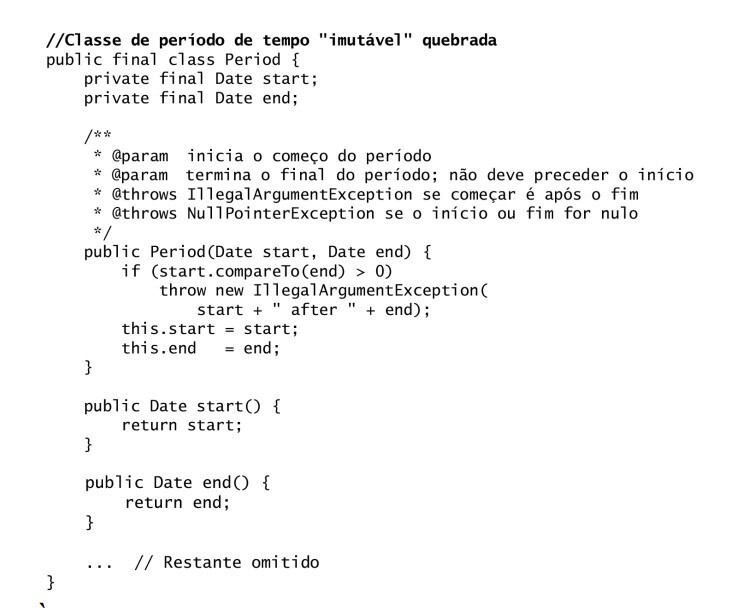"You should program defensively, assuming that clients of your class will do their best to destroy its invariants"
Java as a safe language:
- Java prevents common memory errors in C/C++, but does not fully isolate classes from unwanted interactions with other classes.
- Defensive programming is required, assuming that clients of the class may attempt to violate its invariants.
Immutable classes and security:
- Example of class "Period" that appears immutable but can be corrupted due to the mutability of objects such as Date.
- Solution: Make defensive copies of mutable parameters when receiving them in the constructor.
public Period(Date start, Date end) { this.start = new Date(start.getTime()); // Cópia defensiva this.end = new Date(end.getTime()); if (this.start.compareTo(this.end) > 0) throw new IllegalArgumentException(start + " after " + end); }
Copy after login
e
Defensive copies in builders:
- Defensive copies must be made before validating parameters to avoid vulnerabilities (e.g. TOCTOU attack).
- Avoid using clone() for defensive copies of potentially untrusted objects, preferring static constructors or factory methods.
Getters and mutability:
- Issue: Getters can expose mutable internal components, allowing external mutations.
- Solution: Getters should return defensive copies of mutable objects.
public Date getStart() { return new Date(start.getTime()); // Cópia defensiva }
Copy after login
e
Application to mutable classes:
- Defensive copying also applies to mutable classes that store references to client-supplied mutable objects.
- Example: When storing an object in a Set or Map, one must consider whether the object can be modified later.
Return of internal components:
- When returning mutable internals, consider returning defensive copies or immutable views.
Use of immutable objects:
- Whenever possible, use immutable objects as internal components to avoid the need for defensive copies.
Costs and alternatives:
- Defensive copies can impact performance; Alternatives include relying on documentation or clear usage agreements.
- In cases of explicit transfer of control, such as in design patterns (e.g. wrapper), defensive copy can be dispensed with.
Conclusion:
- Use defensive copies to protect the integrity of classes, except when the cost is impractical or mutual trust is established and clear documentation is required.
Examples from the book:





The above is the detailed content of Item Make defensive copies when necessary. For more information, please follow other related articles on the PHP Chinese website!






 The difference between scilab and matlab
The difference between scilab and matlab The main components that make up the CPU
The main components that make up the CPU How to use the decode function
How to use the decode function What to do if the CPU temperature is too high
What to do if the CPU temperature is too high How to solve the problem that css cannot be loaded
How to solve the problem that css cannot be loaded minidump blue screen
minidump blue screen The difference between null and NULL in c language
The difference between null and NULL in c language How to solve 0xc000409 error
How to solve 0xc000409 error



